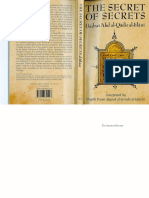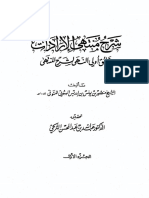0 ratings0% found this document useful (0 votes)
107 viewsBooks To Download
Books To Download
Uploaded by
Mohammed Abdul KhaderSafism was founded in the 13th century by Yohanna in the country of Elam. It is based on Yohanna's teachings and the central concept of Wilaya, referring to divine inspiration received directly from God. After Yohanna's death, various sects and divisions emerged within Safism regarding his successor, doctrines like resurrection, and who had authority over the community. This led to civil wars and the rise of militant orders, with the Kalebids eventually consolidating power in the 14th century and establishing the dominant orthodox interpretation of Safism.
Copyright:
© All Rights Reserved
Available Formats
Download as ODT, PDF, TXT or read online from Scribd
Books To Download
Books To Download
Uploaded by
Mohammed Abdul Khader0 ratings0% found this document useful (0 votes)
107 views9 pagesSafism was founded in the 13th century by Yohanna in the country of Elam. It is based on Yohanna's teachings and the central concept of Wilaya, referring to divine inspiration received directly from God. After Yohanna's death, various sects and divisions emerged within Safism regarding his successor, doctrines like resurrection, and who had authority over the community. This led to civil wars and the rise of militant orders, with the Kalebids eventually consolidating power in the 14th century and establishing the dominant orthodox interpretation of Safism.
Original Description:
some ideas
Original Title
Books to Download - Copy
Copyright
© © All Rights Reserved
Available Formats
ODT, PDF, TXT or read online from Scribd
Share this document
Did you find this document useful?
Is this content inappropriate?
Safism was founded in the 13th century by Yohanna in the country of Elam. It is based on Yohanna's teachings and the central concept of Wilaya, referring to divine inspiration received directly from God. After Yohanna's death, various sects and divisions emerged within Safism regarding his successor, doctrines like resurrection, and who had authority over the community. This led to civil wars and the rise of militant orders, with the Kalebids eventually consolidating power in the 14th century and establishing the dominant orthodox interpretation of Safism.
Copyright:
© All Rights Reserved
Available Formats
Download as ODT, PDF, TXT or read online from Scribd
Download as odt, pdf, or txt
0 ratings0% found this document useful (0 votes)
107 views9 pagesBooks To Download
Books To Download
Uploaded by
Mohammed Abdul KhaderSafism was founded in the 13th century by Yohanna in the country of Elam. It is based on Yohanna's teachings and the central concept of Wilaya, referring to divine inspiration received directly from God. After Yohanna's death, various sects and divisions emerged within Safism regarding his successor, doctrines like resurrection, and who had authority over the community. This led to civil wars and the rise of militant orders, with the Kalebids eventually consolidating power in the 14th century and establishing the dominant orthodox interpretation of Safism.
Copyright:
© All Rights Reserved
Available Formats
Download as ODT, PDF, TXT or read online from Scribd
Download as odt, pdf, or txt
You are on page 1of 9
Safism
Safism was founded by Yohanna
(1239-1273). It is described as a
Millat, a Tariqa and a Silsila. Safism
was established in the 13th century
in the country of Elam. It is based on
the teachings of Yohanna, regarded
as a Wali (saint). The institution of
Wilaya is central to Safism. A Wali is
a recipient of Ilham (divine
inspiration), direct guidance and
inspiration from God Himself. Safism
is a monotheistic faith, based on the
Wahdat or unity of God. Yohanna
was believed to be a faith healer
who acquired disciples and travelled
extensively in the country of Elam.
He established the Safi Tariqa,
acquiring disciples and followers
from diverse faiths, including
Muslims, Jews, Christians and
Zoroastrians. The Shahada
(martyrdom) of Yohanna in 1273.
Yohannas main followers in the
town of Roza, Elam. The Safi tariqa
or silsila. Its movement spreads. In
the land of Elam, ruled by the
Muridin (disciples).
Today, the Safis in Elam, intensely
loyal to Yohanna, whom they regard
as their Wali (saint), Imam (leader),
and Hadi (guide). Some Safis believe
that Yohanna was not martyred, but
that he went into hiding, or Ghaiba.
Others insist that he will be either
reincarnated or resurrected and
return to lead the faithful at the end
of the age. These apocalyptic sects
of Safis have traditionally been at
loggerheads with more orthodox
Safis who reject such doctrines. Still,
another important division was
regarding the administration and
leadership of the Millat after
Yohannas martyrdom. Some of the
community referred to the authority
of the Muridin (disciples) who
formed the first council to regulate
the affairs of the community and
maintain the Mazar. Based on his
divine inspiration, Yohanna wrote
the Sahifa, the sacred text of
Safism, which contains praises of
God that are recited in the Mazar.
The original scroll of the Sahifa is
contained in the Mazar as a relic,
along with other relics, such as
Yohannas stick and cloak.
The first Safi civil war broke out
shortly after Yohannas martyrdom
in 1273. The Muridin organized an
armed campaign to crush the
apostate movement which they
blamed for having assassinated
Yohanna. The Muridin did battle with
the rebellious tribesmen, but the
latter were finally compelled to
cease their hostilities and sign a
treaty. During this civil war, there
were false saints and false
successors, those claiming to be
Yohannas hand-picked successor,
those who rallied to his son Yahya,
those who claimed to be Yohanna
themselves, those who believed
they had inherited Wilaya from him.
The Muridin faught against all of the
pretenders.
But soon, armed factions began to
appear, each wanting to take control
of the community. Warlords
appeared, and religious leaders and
revivalists launching armed
insurrections against the leadership
of the Muridin. These included a new
movement of zealous fighters which
wanted to spread the Tariqa through
violence, and holy war, known as
Malhama. They claimed to inherit
the legacy of the Muridin, who had
engaged in Malhama. The violent
fanatics formed a martial order,
where initiates were taught not only
the spiritual disciplines of the Tariqa
and how to read the Sahifa, but also
martial arts and training with
weapons. This martial order carrying
weapons, swords, arrows, spears,
daggers, etc. They also took it upon
themselves to guard the Mazar. Out
of this militant order arose Kaleb,
who later established the Kalebid
dynasty, consolidating his control
over the country. In the 14th
century, the Kalebids became the
undisputed rulers of Elam. They
easily put down dozens of
insurrections, including from various
unorthodox sects, but also from the
zealous martial orders who believed
that the Kalebids had betrayed them
by indulging in luxury. The Kalebids
had to frequently put down
rebellions from the martial orders,
but tried to integrate initiates of the
martial orders into the regular army,
bribing them with positions of
command. Thus the Kalebids
succeeding in disrupting the martial
orders to some extent. The Kalebids
nurtured the establishment of the
quietist orthodoxy which
emphasized the seven points of
Safism:
1. Oneness of God
2. Sainthood of Yohanna
3. Inspiration of Sahifa
4. Pilgrimage to Mazar
5. Celebration of Wilada
6. Following the Tariqa
7. Defense of Milla
Although orthodox Safis agreed
there were seven points, they did
not always agree on what
constituted these points. Some of
them included paying of Sadaqa, a
religious tax, while others did not
recognize celebration of Wilada, or
did not recognize fighting of
Malhama. For example, these are
our seven points:
1. Oneness of God
2. Sainthood of Yohanna
3. Reading of Sahifa
4. Pilgrimage of Mazar
5. Paying of Sadaqa
6. Offering of Qurban
7. Following of Tariqa
Differences over Sadaqa, Wilada,
Qurban, Malhama.
Yusuf Kawkabi, the pre-eminent Safi
historian of the late 14th century, in
his Chronicles records the history of
Safism and the early Safi sects,
groups and factions. Kawkabi was
considered the greatest scribe,
scholar, philosopher, legalist, jurist,
teacher, and historian of Safism.
Kawkabis defense of the seven
points?
Kawkabis book:
An Ellucidation of the Seven Points
by Yusuf Kawkabi (English trans.)
Kawkabi defines the seven points:
i. Oneness of God (Wahda)
ii. Sainthood of Yohanna (Wilaya)
iii. Inspiration of Sahifa
iv. Pilgrimage of Mazar (Ziyara)
v. Celebration of Birthday (Wilada)
vi. Following of Path (Tariqa)
vii. Unity of Community (Milla)
What is described as Kawkabian
orthodoxy, and pre-Kawkabian
orthodoxy.
Kawkabis writings studied by Wells.
Kawkabian orthodoxy, the chronicles
of Kawkabi.
You might also like
- Secret of Secrets Sirr Ul Asrar (English) Abd Al Qadir Al Jilani PDFDocument88 pagesSecret of Secrets Sirr Ul Asrar (English) Abd Al Qadir Al Jilani PDFMohammed Abdul Khader100% (2)
- Counseling Case Conceptualization Andrews FinalDocument11 pagesCounseling Case Conceptualization Andrews Finalapi-269876030100% (2)
- Origin of ShrinersDocument4 pagesOrigin of ShrinersMarcus Why100% (8)
- Abdelkader & Abdelkrim Religious Influences On Their Thoughts and ActionsDocument41 pagesAbdelkader & Abdelkrim Religious Influences On Their Thoughts and ActionsnabochodNo ratings yet
- AlawiDocument9 pagesAlawiVero100% (1)
- Between Foreigners and Shi‘is: Nineteenth-Century Iran and its Jewish MinorityFrom EverandBetween Foreigners and Shi‘is: Nineteenth-Century Iran and its Jewish MinorityNo ratings yet
- Messerschmitt BF 109 FIGHTER 1935Document114 pagesMesserschmitt BF 109 FIGHTER 1935Mihai Iavorschi100% (3)
- Auto Continuum PDFDocument164 pagesAuto Continuum PDFJosé Carlos de Alencar Dias100% (2)
- Religion & Religiosity Assignment-1Document9 pagesReligion & Religiosity Assignment-1Shambhavi YadavNo ratings yet
- Islam and The Spread of The Sufi OrdersDocument3 pagesIslam and The Spread of The Sufi OrdersBruno BartelNo ratings yet
- Historique de La Family Swaray - WilkipediaDocument6 pagesHistorique de La Family Swaray - WilkipediamustaphaNo ratings yet
- Pazouki - SultanAlishahi GunabadiDocument12 pagesPazouki - SultanAlishahi GunabadialimoazzamiNo ratings yet
- Beyond The Karbala Paradigm Rethinking RDocument18 pagesBeyond The Karbala Paradigm Rethinking RMustafa Al-HusseiniNo ratings yet
- 7-Not Sunnis or ShiasDocument2 pages7-Not Sunnis or ShiasBasit AzizNo ratings yet
- The Developments of Religio-Plitical Movements - S24Document17 pagesThe Developments of Religio-Plitical Movements - S24alattar.mariamNo ratings yet
- Daftary-Ismls TraditionssDocument21 pagesDaftary-Ismls TraditionssNouman AliNo ratings yet
- Theme-2 EnglishDocument12 pagesTheme-2 EnglishpanchamimadhavanNo ratings yet
- R CHIH-YassineDocument25 pagesR CHIH-YassinedonkonkeeNo ratings yet
- Class 12 History Notes Chapter 6 BhaktiDocument7 pagesClass 12 History Notes Chapter 6 BhaktiAhsas 60800% (1)
- Russian 216 TestDocument3 pagesRussian 216 TestAkademik S1 FEBNo ratings yet
- Sunni and Shi'aDocument8 pagesSunni and Shi'aGabriel HaddadNo ratings yet
- Emergence of IslamDocument13 pagesEmergence of Islamgemmabindra100% (2)
- An Essay On SufismDocument4 pagesAn Essay On SufismGreat ExplainerNo ratings yet
- IbadiDocument3 pagesIbadiKhateeb Ul Islam QadriNo ratings yet
- The Salafis in America The Rise Decline and Prospects For A Sunni Muslim Movement Among African AmericansDocument21 pagesThe Salafis in America The Rise Decline and Prospects For A Sunni Muslim Movement Among African AmericansMaroonCastNo ratings yet
- Cortese-Calderini - Women and The Fatimids in The World of IslamDocument8 pagesCortese-Calderini - Women and The Fatimids in The World of IslamAmir De MartinoNo ratings yet
- Conditions of Arab Before IslamDocument8 pagesConditions of Arab Before IslamKhansa CheemaNo ratings yet
- Sectarianism in Pakistan: Causes & Remedies: AbstractDocument42 pagesSectarianism in Pakistan: Causes & Remedies: AbstractŠÿêdà PäkëēžâNo ratings yet
- Furnish, T.R. 2013. Sufis v. Salafis - Winning Friends and Interdicting Enemies in Islamic Africa. RIMA Policy Papers, 1 1Document26 pagesFurnish, T.R. 2013. Sufis v. Salafis - Winning Friends and Interdicting Enemies in Islamic Africa. RIMA Policy Papers, 1 1cmjollNo ratings yet
- Smaililer - Yanl - Tan - T - Lan Bir - II M - SL - Man Toplulu - U (#1131967) - 2491548Document16 pagesSmaililer - Yanl - Tan - T - Lan Bir - II M - SL - Man Toplulu - U (#1131967) - 2491548Vatani AlidodovNo ratings yet
- The Alamiit Period in Nizari Ismaili HistoryDocument39 pagesThe Alamiit Period in Nizari Ismaili HistoryA.A. OsigweNo ratings yet
- Islamic History 8 & 10Document7 pagesIslamic History 8 & 10Percy CreadoNo ratings yet
- Sufi Brotherhoods in Syria and Israel - A Contemporary OverviewDocument20 pagesSufi Brotherhoods in Syria and Israel - A Contemporary OverviewBruno BartelNo ratings yet
- Zaydiyya (From The Encyclopaedia of Islam)Document8 pagesZaydiyya (From The Encyclopaedia of Islam)Shahid.Khan1982No ratings yet
- Imamate PDFDocument16 pagesImamate PDFsaidatuladaniNo ratings yet
- Evolution of Ritual Commemoration of The Battle of KarbalaDocument11 pagesEvolution of Ritual Commemoration of The Battle of KarbalaMahmoud MrouehNo ratings yet
- Farah Islam 174-179Document4 pagesFarah Islam 174-179colli9No ratings yet
- The Meanings of Timbuktu - Chapter 13 - The Life of Shaykh Sidi Al-Mukhtar Al-KuntiDocument22 pagesThe Meanings of Timbuktu - Chapter 13 - The Life of Shaykh Sidi Al-Mukhtar Al-KuntiAbdouNo ratings yet
- Rise of IslamDocument22 pagesRise of IslamayushNo ratings yet
- The Baatinee Movements, Secret Organizations, Freemasonry, Al-Ikhwaan, Al-Qaidah and ISIS: Part 3 - The Activities of Jamaal Al-Deen Al-IraaneeDocument26 pagesThe Baatinee Movements, Secret Organizations, Freemasonry, Al-Ikhwaan, Al-Qaidah and ISIS: Part 3 - The Activities of Jamaal Al-Deen Al-IraaneeOnder-KofferNo ratings yet
- Reading MaterialDocument5 pagesReading MaterialKartikay FauzdarNo ratings yet
- Sirah NabawiyahDocument93 pagesSirah NabawiyahAl BadawyNo ratings yet
- Islamic Schools and Branches - WikipediaDocument30 pagesIslamic Schools and Branches - WikipediaDamilare Daniel OlaniyiNo ratings yet
- Isma'ilismDocument22 pagesIsma'ilismT 4No ratings yet
- Assignment On Suhrawardy Order2Document22 pagesAssignment On Suhrawardy Order2zasxcdfvNo ratings yet
- From Alid Treatise To Anti Shii Text TDocument5 pagesFrom Alid Treatise To Anti Shii Text Tandini14damasariNo ratings yet
- Potter, Lawrence, Sufis and Sultans in Post-Mongol IranDocument27 pagesPotter, Lawrence, Sufis and Sultans in Post-Mongol IranhulegukhanNo ratings yet
- Shi'i Sunni DivideDocument4 pagesShi'i Sunni DividealburoojNo ratings yet
- God's Armies: Crusade and Jihad: Origins, History, AftermathFrom EverandGod's Armies: Crusade and Jihad: Origins, History, AftermathNo ratings yet
- MARSHALL G. S. HODGSON The Secret Order of Assassins The Struggle of The EarlyDocument2 pagesMARSHALL G. S. HODGSON The Secret Order of Assassins The Struggle of The EarlyCvrator Harmoniae0% (1)
- What Does Azadari Mean For The ShiasDocument8 pagesWhat Does Azadari Mean For The ShiasAle NatiqNo ratings yet
- Book RewiewDocument8 pagesBook RewiewHanif UllahNo ratings yet
- Acts07 Pharisees BruceDocument1 pageActs07 Pharisees BruceLeandro SjpNo ratings yet
- Arjomand, Said Amir (1996) - The Crisis of The Imamate and The Institution of Occultation in Twelver Shiism - A Sociohistorical PerspectiveDocument26 pagesArjomand, Said Amir (1996) - The Crisis of The Imamate and The Institution of Occultation in Twelver Shiism - A Sociohistorical PerspectivemithraslordoflightNo ratings yet
- Asatryan M - An Early Shi - I Cosmology Kitab Al-Ashbah Wa-L-Azilla and Its Milieu - 2015Document80 pagesAsatryan M - An Early Shi - I Cosmology Kitab Al-Ashbah Wa-L-Azilla and Its Milieu - 2015Syed Danial ZaidiNo ratings yet
- Isma'ilismDocument24 pagesIsma'ilismnaveedbro666No ratings yet
- The Myth of The Clerical Migration To Safawid Iran: Arab Shiite Opposition To Alī Al-Karakī and Safawid ShiismDocument48 pagesThe Myth of The Clerical Migration To Safawid Iran: Arab Shiite Opposition To Alī Al-Karakī and Safawid ShiismMohamed H Rajmohamed100% (1)
- Introduction: The Assassin Legends: Myths of The IsmailisDocument7 pagesIntroduction: The Assassin Legends: Myths of The IsmailisShahid.Khan1982No ratings yet
- The Sunni-Shia DivideDocument20 pagesThe Sunni-Shia DivideDaniel Bonilla CalleNo ratings yet
- Hamdani (Sumaiya) - The Dialectic of Power - Sunni-Shi'i Debates in 10th-Century North AfricaDocument18 pagesHamdani (Sumaiya) - The Dialectic of Power - Sunni-Shi'i Debates in 10th-Century North AfricaJean-Pierre MolénatNo ratings yet
- Early Historical Writings: SIYAR (Sirah, Seerah)Document5 pagesEarly Historical Writings: SIYAR (Sirah, Seerah)Shahid IqbalNo ratings yet
- From Insurgents To Hybrid Security Actors? Deconstructing Yemen'S Huthi MovementDocument16 pagesFrom Insurgents To Hybrid Security Actors? Deconstructing Yemen'S Huthi MovementLuisa de CesareNo ratings yet
- A Short History: Foundation of The Safavid StateDocument46 pagesA Short History: Foundation of The Safavid Statedimashqee100% (1)
- Moses and The Holy Valley TuwanDocument9 pagesMoses and The Holy Valley TuwanMohammed Abdul KhaderNo ratings yet
- Apostates and BlasphemersDocument32 pagesApostates and BlasphemersMohammed Abdul KhaderNo ratings yet
- Stvdia Islamica No. 9, 1958 PDFDocument125 pagesStvdia Islamica No. 9, 1958 PDFMohammed Abdul KhaderNo ratings yet
- Mihna of 218 AH RevisitedDocument12 pagesMihna of 218 AH RevisitedMohammed Abdul KhaderNo ratings yet
- Sharh Buhuti 1Document637 pagesSharh Buhuti 1Mohammed Abdul KhaderNo ratings yet
- The Bane of ReductionismDocument6 pagesThe Bane of ReductionismMohammed Abdul KhaderNo ratings yet
- Abd Allah B. Muawiya and The JanahiyahDocument20 pagesAbd Allah B. Muawiya and The JanahiyahMohammed Abdul KhaderNo ratings yet
- Su DentalDocument2 pagesSu DentalMohammed Abdul Khader0% (1)
- Mubahisa RawalpindiDocument333 pagesMubahisa RawalpindiMohammed Abdul KhaderNo ratings yet
- EducationDocument1 pageEducationMohammed Abdul KhaderNo ratings yet
- Books RequiredDocument4 pagesBooks RequiredMohammed Abdul KhaderNo ratings yet
- Risala Sair Ul AqtaabDocument212 pagesRisala Sair Ul AqtaabMohammed Abdul KhaderNo ratings yet
- 35 Christian SectsDocument5 pages35 Christian SectsMohammed Abdul KhaderNo ratings yet
- Good ReferencesDocument5 pagesGood ReferencesMohammed Abdul KhaderNo ratings yet
- Regulations: Also Called Subordinate or DelegatedDocument3 pagesRegulations: Also Called Subordinate or DelegatedMohammed Abdul KhaderNo ratings yet
- Companions of The Cave (Sura 18:10, 16)Document8 pagesCompanions of The Cave (Sura 18:10, 16)Mohammed Abdul KhaderNo ratings yet
- Raf'-ul-Yadain: This Is Also The MâlikiDocument4 pagesRaf'-ul-Yadain: This Is Also The MâlikiMohammed Abdul KhaderNo ratings yet
- Mail ServerDocument11 pagesMail ServerChandresh PrasadNo ratings yet
- Half Yearly Exam Session - 2018-19: Class - V Subject: ENGLISHDocument9 pagesHalf Yearly Exam Session - 2018-19: Class - V Subject: ENGLISHPrabhuNo ratings yet
- Wordsworth and Coleridge On ImaginationDocument4 pagesWordsworth and Coleridge On ImaginationNoor100% (1)
- Disaster ManagementDocument9 pagesDisaster Managementvaruna KNo ratings yet
- Fundamentals of Electromagnetic Compatibility (EMC) DesignDocument28 pagesFundamentals of Electromagnetic Compatibility (EMC) DesignSasidhar Reddy VundelaNo ratings yet
- English m5 q2Document34 pagesEnglish m5 q2nelie tumpapNo ratings yet
- Microscopy and StainingDocument7 pagesMicroscopy and StainingDenmark ManlusocNo ratings yet
- Qatar's National ICT Plan 2015: Advancing The Digital AgendaDocument48 pagesQatar's National ICT Plan 2015: Advancing The Digital AgendaictQATAR100% (1)
- 01 DWK DURAN Bottle-System Brochure en UPDATE VIEWDocument4 pages01 DWK DURAN Bottle-System Brochure en UPDATE VIEWsudhirbhuvadNo ratings yet
- AQA Set 3 Foundation GCSE Math Paper 1Document22 pagesAQA Set 3 Foundation GCSE Math Paper 1bagaj11052No ratings yet
- IFMA FMPv3-0 F-B Ch4Document46 pagesIFMA FMPv3-0 F-B Ch4Mohamed IbrahimNo ratings yet
- Reading MidtermDocument11 pagesReading MidtermHồ Như QuỳnhNo ratings yet
- Instructions For Authors: Essential Title Page InformationDocument4 pagesInstructions For Authors: Essential Title Page InformationKHUSHBU BHALODIYANo ratings yet
- Exercicio Aulas 10 A 13Document7 pagesExercicio Aulas 10 A 13kaueNo ratings yet
- Organizational Culture DiagramDocument3 pagesOrganizational Culture Diagramfahad muhammadNo ratings yet
- Chap 003Document8 pagesChap 003Anum SayyedNo ratings yet
- Mis 21 1,2,3Document34 pagesMis 21 1,2,3Arbaz ShahNo ratings yet
- ON Sci 9 Unit1 Sec12Document7 pagesON Sci 9 Unit1 Sec12Girlie Kaye PagtamaNo ratings yet
- AnimalKingdom PpsDocument23 pagesAnimalKingdom PpsNada DinićNo ratings yet
- Activity #1 ReflectionDocument1 pageActivity #1 ReflectionIvy Claire Segundo TorresNo ratings yet
- SMK Green Road Term 2 Trial Exam 2019 MSDocument4 pagesSMK Green Road Term 2 Trial Exam 2019 MSvoon sjNo ratings yet
- Snake: Snakes Are ElongatedDocument12 pagesSnake: Snakes Are ElongatedDariz MillerNo ratings yet
- Code of EthicsDocument11 pagesCode of EthicsmuhammadosamaNo ratings yet
- ONVIF Imaging Service SpecDocument16 pagesONVIF Imaging Service Specjmathew_984887No ratings yet
- LogDocument27 pagesLogchaaanrikkaNo ratings yet
- Hci Assig 031, 050, 023Document10 pagesHci Assig 031, 050, 023Juiyyy TtttNo ratings yet
- Noli Me TangereDocument4 pagesNoli Me TangereGrace Cañones-TandasNo ratings yet











































































































